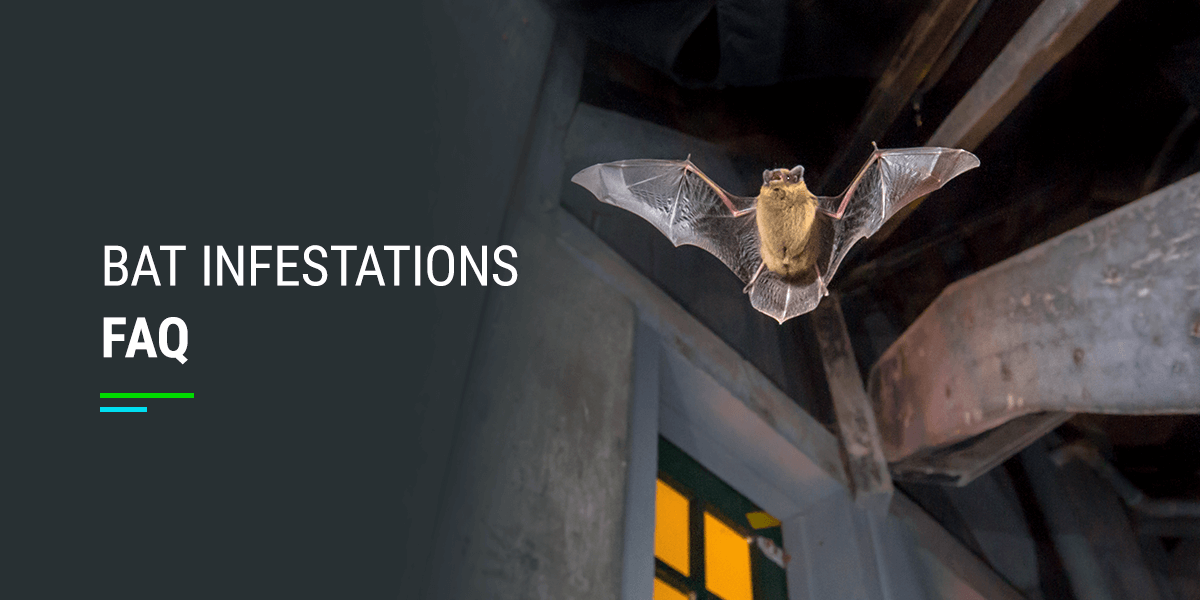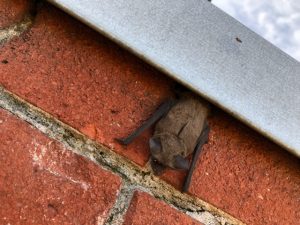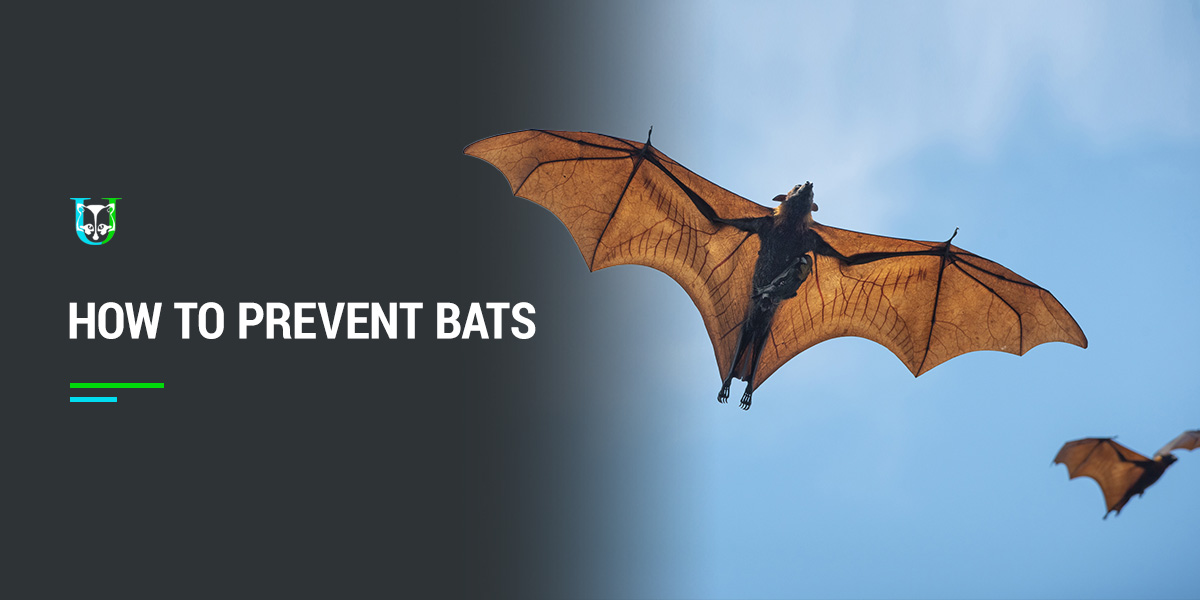
Bats are not as dangerous to humans as their reputation makes people believe. They are incredibly beneficial to the environment because they help control insect populations, and some species are great pollinators. However, despite their benefits, bats can be a nuisance if they roost in your home or business. Bats can cause structural damage to your house and pose health hazards.
Bats are federally protected, so both the federal government and states have laws to protect them and ensure they are removed from homes and businesses safely. Removing bats on your own can be dangerous and pose health risks, but a professional can remove bats safely and legally.
We created this guide with common bat FAQs to help you understand more about bat infestations.
1. Why Do Bats Appear So Suddenly During an Infestation?
Bats may suddenly appear in the late spring and early fall when mothers deliver and raise their pups, as attics and other areas of the home make ideal warm, dry, and empty spaces to nest. Bats also hibernate in the winter to protect themselves from the elements and maintain access to a food supply, so they may suddenly appear when the weather gets colder.
Other reasons bats may appear include:
- Unsupervised baby bats exploring or falling through gaps in homes.
- Bats mistakenly fly through open windows while hunting or seeking cover during rainfall.
- Pet cats bring bats indoors after hunting.
Bats can fit through an entry point as small as 3/8 of an inch, so they can easily gain access to homes through cracks and gaps in your attic. Once they enter, an infestation can occur.
2. What Are the Signs of a Bat Infestation?
Bat droppings, stained ceilings, odors, and chirping sounds may indicate a bat infestation. Here’s how to determine whether bats have invaded your home:
- High-pitched chirping: Bats emit a high-pitched squeaking sound often mistaken for birds. If you hear chirping within your walls or in your attic, this could be a sign of a bat infestation.
- Stained ceilings: Bats create moisture from droppings, urine, and body temperatures. Over time, these can build up, and you may notice greasy or oily stains on your ceiling or walls near entry points.
- Droppings: Bat droppings, or guano, which are dark brown and pebble-shaped, are a giveaway that you have bats living in your home. Avoid bat droppings, as they can be detrimental to pet and human health.
- Ammonia odor: Bat guano secretes a pungent ammonia odor. If you smell it, avoid breathing it in, as the fumes can be harmful.
You might notice bat entry points anywhere, as long as the crack or crevice is large enough for them. Common areas include chimney cracks, roof lines, and between sliding bricks.
3. How Serious Is a Bat Infestation?
A bat infestation can be serious, as these animals can spread rabies and histoplasmosis. Rabies is a viral disease that causes brain inflammation in humans and animals. You can be exposed to rabies when an infected animal, such as a bat, bites. While most bats do not have rabies — and are unlikely to bite unless threatened — it can still happen. And since their teeth are so small, many people are unaware when they’ve been bitten. Additionally, bats can cause allergic reactions in some people, including congestion and asthma.
Bat droppings can also cause structural damage to your home by eating away at wood and other building materials. If you encounter a bat in your living space, it’s important that you call bat control specialists. These trained technicians can assess the situation to address the problem quickly and safely — preventing health and structural damage risks.
4. Are Bats Hard to Get Rid Of?
Bats can be hard to get rid of without professional help. Bat colonies can reproduce and return year after year, as they prefer to return to the same roost. They may destroy your insulation and cover your home in droppings. Plus, no matter how many bats are roosting in your home, they can have many entry points that you are unaware of. As a result, professional bat control services provide the best response to bat infestation.
5. What Should You Do About Bat Infestations?
The best response to bat infestations involves hiring a professional. Technicians have the knowledge and expertise to assess entry points and install one-way doors to prevent re-entry. They will keep the devices in place until it’s time to remove them and then will seal all entry points to help keep bats away for good. Once the issue is resolved, you can take steps to keep bats away from your property. These might include:
- Shining a bright light at the former entry point for a week.
- Hanging reflective objects around your home, such as CDs.
- Scenting your home with smells bats dislike, such as cinnamon, peppermint, or eucalyptus.
- Ensuring all potential entry points are safely sealed, including cracks or gaps in walls, your roof, chimneys, and vents.
- Installing bat boxes as an alternative roosting location for the bats.
- Installing screens over chimneys and vents to prevent bats from re-entering.
- Keeping your home clean to exterminate potential food sources for bats, like gnats and other insects.
6. Will Bats Eventually Leave the House?
Bats can live in your home indefinitely without professional bat pest control. If they find a spot they can quickly enter and leave from, they may return to continue roosting and growing their colony. While you may be tempted to wait and see if they leave on their own, over time, bats can cause infestations, make noise, leave droppings, cause structural damage, and carry potential diseases harmful to humans and pets.
7. How Long Does It Take to Get Rid of a Bat Infestation?
Getting rid of a bat infestation may take a few days or a few months, depending on the size of the colony, the species, the roosting location, the season, and legal restrictions. Professionals like Urban Jungle Wildlife Removal use a methodical approach to resolve pest issues as quickly and efficiently as possible. We protect your home from future infestations by applying preventive measures, such as repairing the holes the bats came through.
8. How Much Does It Cost to Get Rid of Bats?
The cost of getting rid of bats — referred to as pest exclusion — will depend on the type of service. Prices may be higher than other pest-related services due to the live catch-and-release methods professionals use when dealing with bat infestations. Bat exclusion may cost anywhere from a few hundred dollars to over $8,000. Inspections and guano removal services will likely fall on the lower end of that spectrum. Professionals can determine the cost upon inspection of the home.
9. Does Insurance Cover Bat Infestations?
While homeowners insurance will not cover bat removal, it may cover the damage caused by the bats. You’ll want to check your specific insurance policy, as it may have stipulations about the type of damage covered. For instance, homeowners insurance may not cover damage repair if the bats were left to roost for a very long time. As a result, it’s critical to address infestations quickly.
10. When Should You Call a Professional for Bat Infestation Issues?
You should call for professional bat exclusion services as soon as you notice signs of an infestation. Quick action can minimize the extent of the infestation and reduce the risk of structural damage and health risks. Tackling a bat infestation goes further than waiting it out or attempting to remove them on your own. Calling professionals is the safest and most efficient way to handle a bat infestation.
Contact Urban Jungle Wildlife Removal for Bat Eviction Services
Bats are a protected species and important to the environment, so protecting them is important. However, they can pose health risks and damage your home’s structure if they make their way into your attic or chimney. Removing bats on your own is dangerous, and killing them is illegal. Hiring wildlife removal experts to evict bats from your home is essential to ensure the bats are removed safely and legally.
Urban Jungle Wildlife Removal offers bat removal and exclusion services to evict bats from your home, repair damage, and prevent further infestation. Our experienced professionals are trained to handle wildlife and seal homes to safeguard them against re-entry.
Contact us to learn how we can remove and exclude animals from your house for a safe, clean home.
Call Now for Wildlife Removal Services➔



